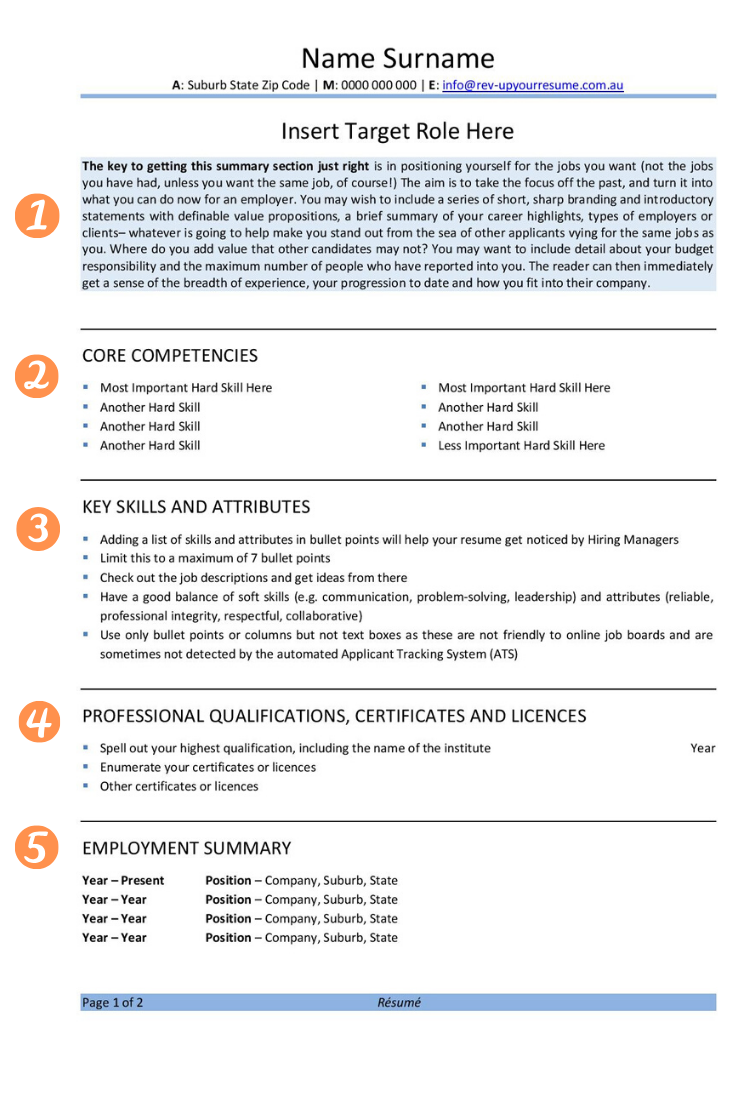Being in resume writing business for 10+ years, one of the most common questions we’ve been receiving from clients is if there’s a need to customise their resume for each job application.
Our advice has been simple.
There’s no need to customise your Australian resume if the jobs you’re applying for are very similar.
But if you’re applying for positions that require different skill sets (for example, Sales Representative and Sales Manager), a cookie-cutter, generic resume won’t make the initial cut.
The good news? Customising your resume doesn’t mean having to rewrite the entire content.
Regardless of the job you’re applying for, you can keep several things consistent while still tailoring other parts.
Here’s a quick rundown on what parts of your resume should change for each position you apply for, and what you can keep the same.
What you can keep
Start by creating a generalised resume as your basis to work off of. Create a ‘base’ resume version that has:
- A strong personal statement / professional profile – click here to learn how to write your personal statement
- A core competencies section – this is the keyword section of the resume; ideally, should be between 8 and 14 competencies only
- A list of other skills and attributes – a mix of soft and hard skills; ideally, should be maximum of 7 bullet points
- A list of your qualifications, training, certifications and licences
- An employment summary section – to provide the reader with a quick snapshot of your work history
- A detailed work experience section (page 2 onwards) that gives a brief description of your responsibilities and achievements
This is your ‘base’ resume. It’s typically longer since it has all information about everything you’ve done in your career.
But it provides a starting framework for you to add and condense, as necessary.
No matter what job you apply for, you likely won’t need to update facts like company names and education.
What you leave in or remove will depend on the job description, but below are the sections that you can customise.

What to change
Personal Statement / Professional Profile
This is your first chance to capture a recruiter or hiring manager’s attention, so make sure it matches what they’re looking for.
As discussed here, your personal statement summarises your career and details the extent of your experience.
You may also want to write the actual position you’re applying for at the top of the resume.
This is also a good place to mention why you’re a good cultural fit. If the company you’re applying for is focused on sustainable practices, for example, you could add a sentence about how you’ve demonstrated your passion for this.
Career Achievements
A critical mistake in applying to multiple companies is keeping the same bulleted accomplishments in your professional experience section from one application to another.
These accomplishments should be customised based on the requirements expressed in the job description of the position.
For example, if you’re applying for a sales representative role, you will need to mention your achievements related to sales growth and business development. But if you’re applying for a Sales Manager role, your focus should be in managing and motivating teams as well as making business decisions.
Also, keep in mind the order of how these achievements are listed. You should prioritise more relevant accomplishments towards the top.
Core Competencies, Skills and Attributes
Even if you’re responding to three different job postings with the same job title, each role could have different expectations in terms of the skills they expect you to have.
Print out a copy of the job description and highlight the competencies, skills and attributes the hiring manager is looking for. They try to incorporate these into your Core Competencies and/or Skills and Attributes sections.
Make sure to use the exact words used in the job description. You need to do this especially if the company you’re applying to uses software to scan your resume and match keywords against the job ad.
Job Titles (both in Employment Summary and Detailed Work Experience sections)
Job titles are one of the easiest elements of your resume for hiring managers to scan through.
You don’t always have the flexibility to change your job title. It’s also important not to lie on your resume.
But sometimes, you can make minor changes to help get you message across more clearly.
For example, if your official title is VP of Marketing at a small agency, but targeting a mid-level position with a bigger company, you might think about modifying that to: VP of Marketing (Equivalent to Marketing Manager).
This also goes for those who own their start-up companies or are self-employed and refer to their title on resume as ‘CEO.’ If you’re applying for a mid-level operational role, consider changing this to: CEO (Equivalent to Operations Manager).
The order of your work history
This tip won’t apply to every job seeker, but to those in specific circumstances, rearranging the order of work history gives the resume a real boost.
For example, if you’ve had both sales and software engineering experience and are applying to roles in both fields you’ll want to make sure that most relevant positions are highlighted rather than your most recent ones.
You can do this in two ways:
- You can change the ‘Employment Summary’ section to ‘Relevant Experience.’ Include only the relevant experience (for example, sales if applying for sales roles; software engineering if applying for IT roles).
- You can split the ‘Detailed Work Experience’ section into: ‘Relevant Experience’ and ‘Other Work Experience’
In summary
It may seem a lot of work to tailor your resume to each job opportunities, but remember – job search is all about quality and not quantity.
If you submit a customised resume to three different companies, your odds are almost the same if you sent out a generic resume to 30 employers!
If you’re still having difficulties customising your resume to every role, email us. We might be able to help.
Looking for more job search tips? Click here.
For more ideas on how to craft a winning resume, visit www.rev-upyourresume.com.au or connect with us through LinkedIn, Twitter, and Facebook.

